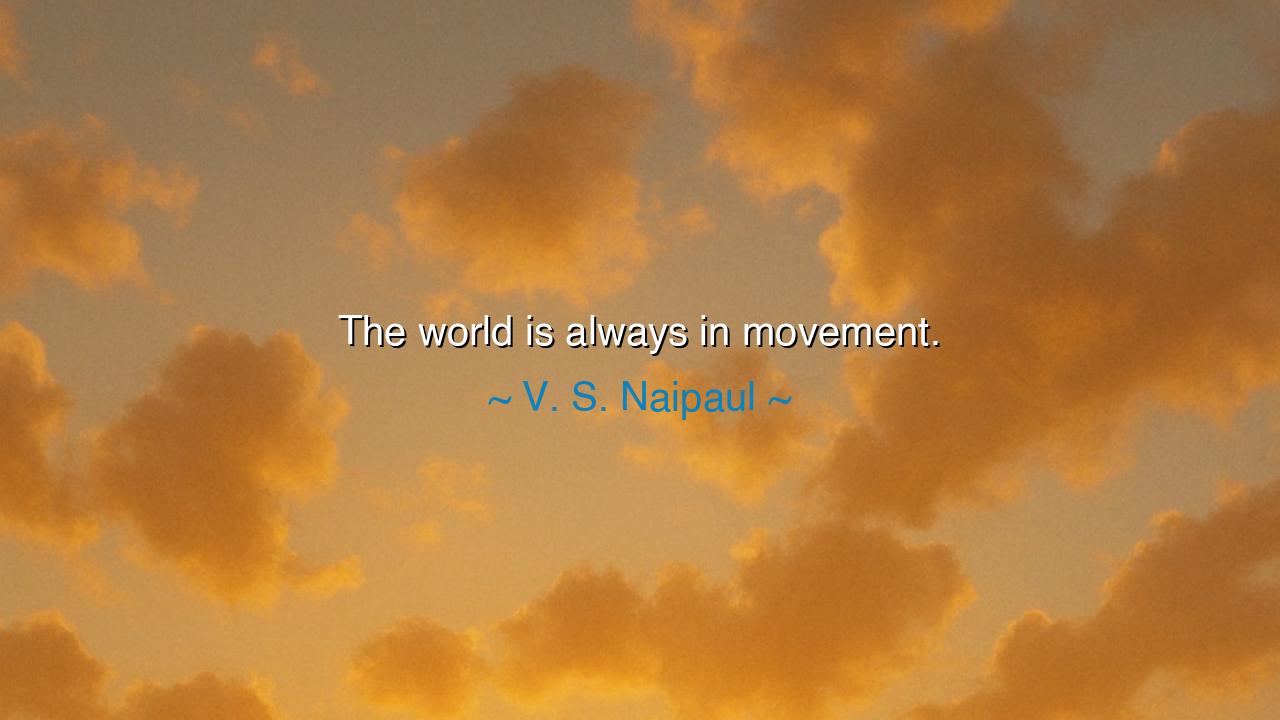
The world is always in movement.






V. S. Naipaul once wrote: “The world is always in movement.” In this short, radiant line, he captures the eternal truth of existence—that nothing stands still, nothing remains as it was, and all things flow like a river that cannot be stepped into twice. The world is never fixed, for kingdoms rise and fall, generations come and go, and even the mountains, which seem eternal, wear down under time. To recognize this movement is to awaken to the pulse of life itself, for to resist it is to break, but to flow with it is to grow.
The origin of this thought rests in Naipaul’s life as a traveler, observer, and chronicler of civilizations. Born in Trinidad, carrying the inheritance of Indian ancestry, and writing in England, he himself embodied the truth of constant movement—a man shaped by migration, history, and the clash of cultures. His works often reflected on how nations transform, how traditions evolve, how identities shift. Thus, his words are both a personal confession and a universal law: the world is never still, and we must learn to live with its unending tides.
The ancients knew this truth well. Heraclitus, the Greek philosopher, declared that all things flow, and that change is the only constant. He said, “You cannot step into the same river twice,” for the waters have already moved on, and so have you. The Buddhists spoke likewise, teaching that impermanence is the nature of all things—that suffering arises when man clings to what must change. Naipaul’s words stand in this lineage, a modern echo of ancient wisdom: the world is always in movement, and wisdom lies in accepting it.
History shows us examples in every age. Think of the fall of Rome. For centuries it seemed eternal, unshakable, the master of the earth. Yet even Rome, the mighty empire, yielded to the movement of time, giving way to new kingdoms, new languages, new faiths. Or think of the age of discovery, when men crossed seas to find unknown lands. That movement of ships reshaped the map of the earth, brought cultures together, and shattered old certainties. The world had changed before, it changed then, and it continues to change now.
But this movement is not only in nations and empires—it is in each life. The child becomes the youth, the youth becomes the elder, and the elder returns to dust. Seasons change, friendships shift, fortunes rise and fall. To imagine that life will always remain as it is, whether in joy or in sorrow, is a deception. Everything passes, everything moves. This truth may wound us when we lose what we love, but it may also console us, for it means that no suffering endures forever.
The lesson, then, is clear: embrace the movement of the world. Do not cling desperately to what must pass, nor despair when the present is heavy. Instead, walk with time as with a companion, learning from each change, growing with each transformation. To resist change is to break like a brittle branch; to accept change is to bend like the reed and rise again. In movement lies both danger and opportunity, both loss and renewal.
Practically, this means cultivating adaptability and humility. When life shifts, do not cry out that the world has betrayed you—know instead that it has always been in movement. Learn new skills, open your heart to new friendships, release bitterness when the past has moved beyond you. Take courage from the truth that even when the path is dark, the world moves, and with it comes the possibility of new light.
Thus, Naipaul’s words shine as a lamp for all travelers on life’s road: “The world is always in movement.” Let them remind you that change is not your enemy but your companion. For in the river of time, the waters may be swift, but they carry us forward, ever onward, toward new shores we have not yet seen. To walk with this truth is to walk with wisdom, and to walk with wisdom is to live in harmony with the eternal flow.






AAdministratorAdministrator
Welcome, honored guests. Please leave a comment, we will respond soon